Patents
Cigarette lighter that gives the finger
In 1942, George Horther was granted a patent for what he called an "electric resistance lighter". From what I can gather, lifting the finger activated the lighter. He had received a separate design patent in 1940 for the invention's appearance.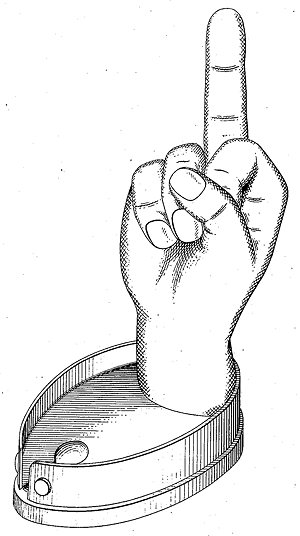
Curiously, in neither patent did Horther ever refer to the significance of the gesture his invention is making, even though that's pretty much the entire point of it.
I imagine he must have intended to sell this as a gag gift, but I can't find any evidence that he ever did manage to market it.
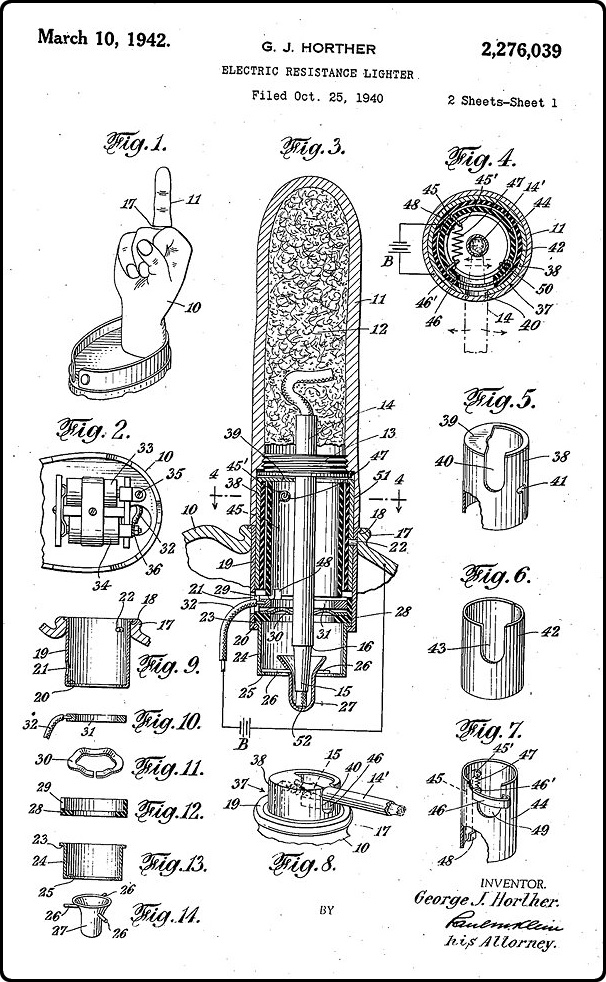
Posted By: Alex - Sun Apr 18, 2021 -
Comments (0)
Category: Inventions, Patents, Smoking and Tobacco, 1940s
Reuben Lindstrom’s Wind Driven Vehicle
In 1940, Reuben Lindstrom was granted a patent for a "wind driven vehicle". It was a toy made out of tin cans. It resembled a model train, and the wind could make it go by itself. In his patent, Lindstrom explained that he deliberately avoided using a sail to propel the toy.Instead, he had shaped the wheels "to constitute wind responsive impeller blades".
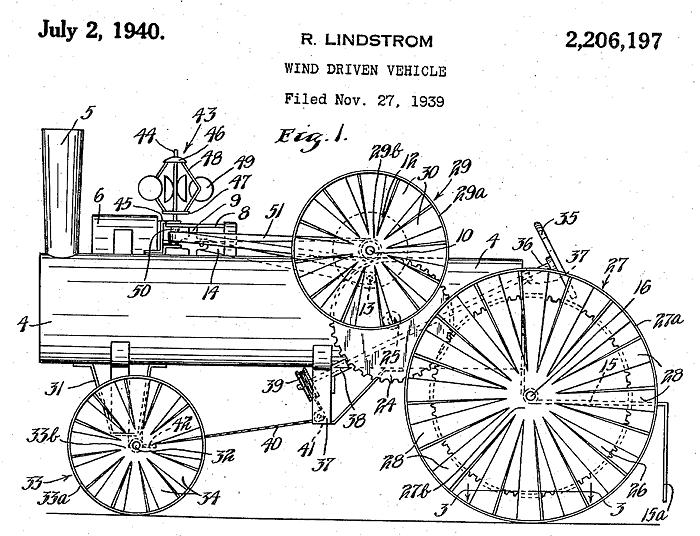
Digging more deeply into the history of this patent, it turns out that Lindstrom was quite a character. For a start, he never cut his hair because, so he said, whenever he did he got heart trouble. In America, in the 1940s, this was unusual enough that it made the news.
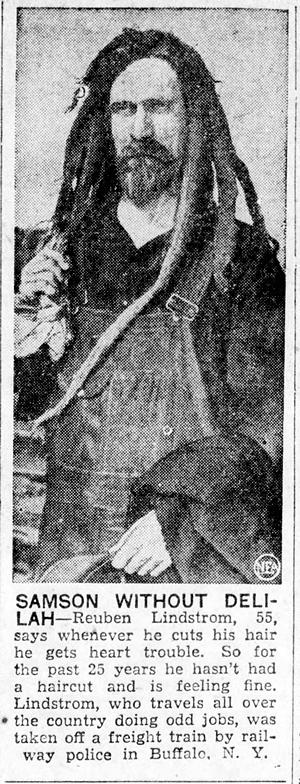
Warren Times Mirror - June 28, 1949
He was a regular fixture around Wisconsin Rapids. A 2001 article in the Wisconsin Rapids Daily Tribune called him "our most unforgettable character."
In addition to his wind-driven toy train, he had built a kind of motorized bicycle, described as a "weird contraption of bicycle wheel, one cylinder gas motor, pulley, levers, scooter and miscellany." He used this to get around on roads and railroad lines.
He basically lived as a street person/free spirit, always carrying around "a picture of a woman with a large snake wrapped around her neck." Some people referred to him as the "inventor hobo".
One of the quotations attributed to him: "Fashion is the main religion of this world. If you are different, they think you are nuts. Most people stay away from me because they think I'm a religious fanatic. The girls also stay away from me."
Also: "Dirt's natural and it keeps human diseases from penetrating the skin and entering my body."
He died in 1988.
There's some more info about him at randyjack.com.
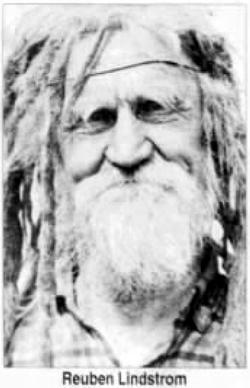
Wisconsin Rapids Daily Tribune - June 9, 2001
Posted By: Alex - Sun Apr 11, 2021 -
Comments (0)
Category: Bums, Hobos, Tramps, Beggars, Panhandlers and Other Streetpeople, Inventions, Patents, Toys, 1940s, Trains
Fire-Breathing Woman
In April 1940, Linda Lancaster Dodge Stratton was granted a patent for the "cigar or cigarette lighter" shown below. Its novel feature was that it was shaped like a fire-breathing woman. Or, as Stratton put it, "in the shape of a human figure artistically posed with the igniting means located in the mouth and ignited and extinguished by the movement of the head to open and close the mouth thereof through the manual movement of the arms toward and from the mouth."It kinda looks like a fire-breathing Barbie. Though it predates Barbie by almost 20 years.
The patent said this woman was to be "constructed in a pocket or a table size." It would definitely be a conversation piece to have a table-size version of her in your home.
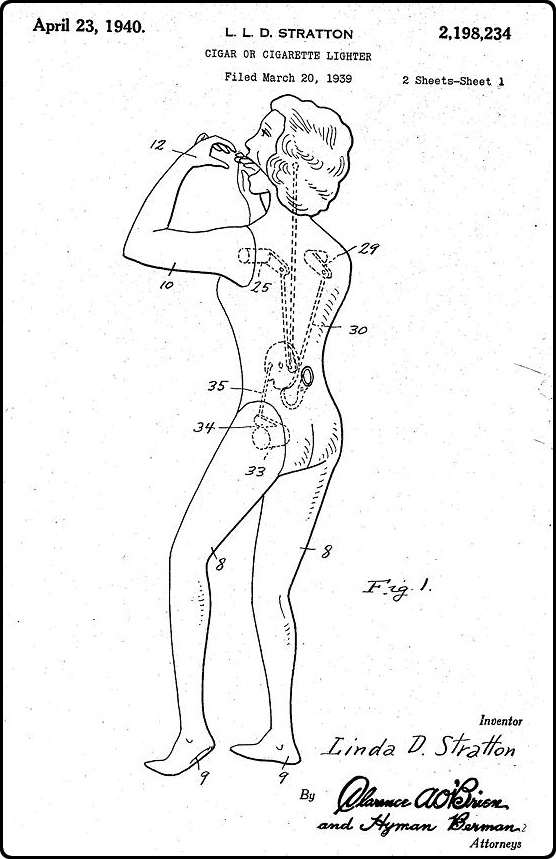
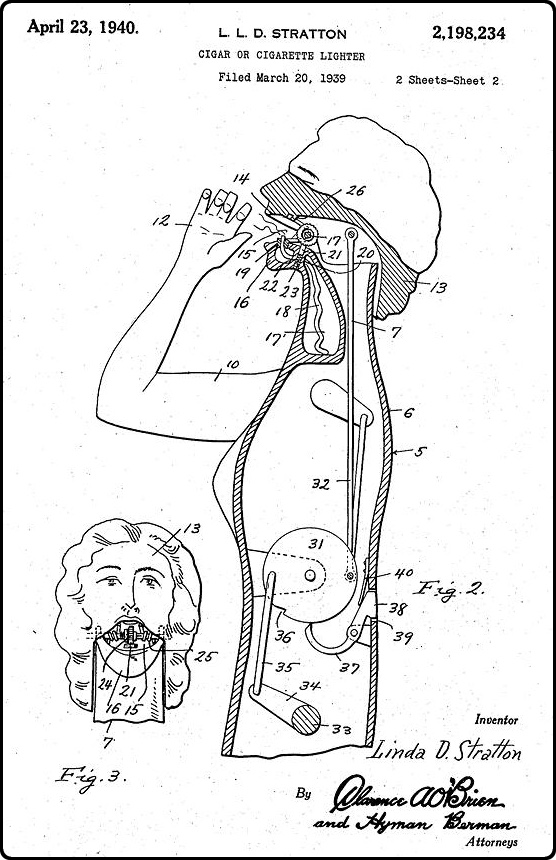
Posted By: Alex - Sun Apr 04, 2021 -
Comments (4)
Category: Inventions, Patents, Smoking and Tobacco, 1940s, Women
Combined Clothes Hanger and Radio
It's fairly common to use metal clothes hangers to extend the range of a radio's antenna. So John Jerome Spina had the idea of combining the radio and clothes hanger into one. The metal of the hanger would serve as the antenna. He was granted a patent for this invention in 1978.I'm not sure he thought through what would then happen if you hung something on the hanger, such as a coat.
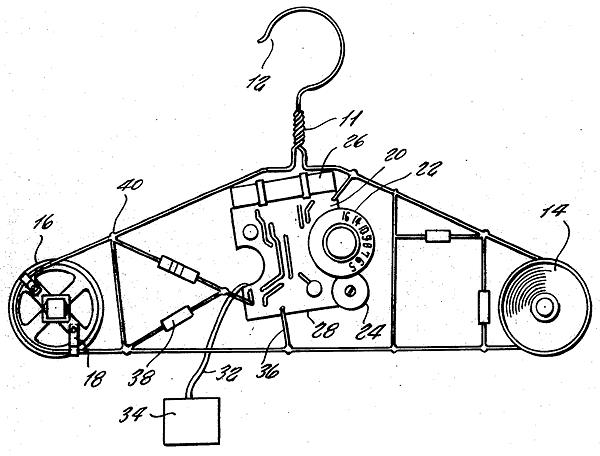
Posted By: Alex - Sun Mar 28, 2021 -
Comments (1)
Category: Inventions, Patents, Radio, Technology, 1970s
Clothes Form
Butler Baker invented a "clothes form" to prevent clothes from sticking to a person's body in hot weather. It consisted of a scaffolding of wire rings to be worn beneath a person's clothes.In his 1927 patent, Baker asserted that these rings would "maintain clothing spaced from the body of the wearer at all times, thereby overcoming the disagreeable feature of the clothing sticking to the body during warm weather." Furthermore, "the device is simple in construction, light, and constructed in a manner whereby it will not interfere with the bending of the body."
It would be even better if it somehow had a fan at the bottom blowing air over your body. You might look weird wearing it, but at least you'd be cool.
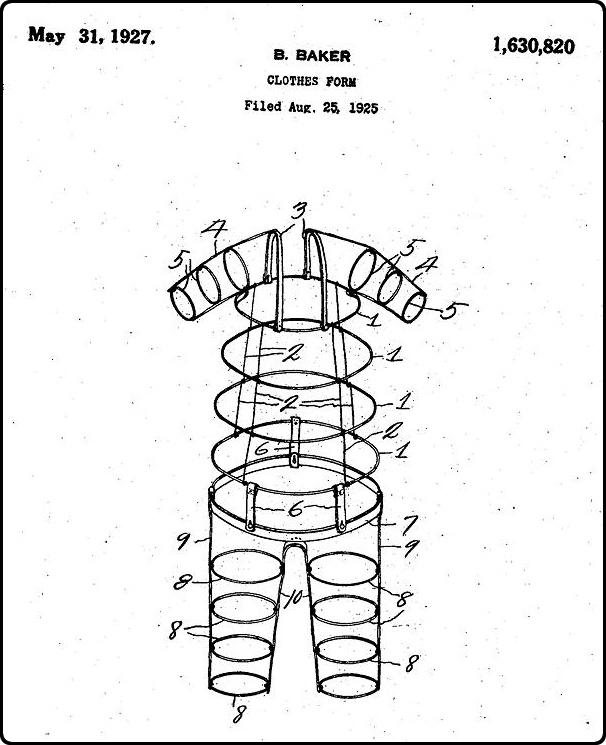
Posted By: Alex - Sun Mar 21, 2021 -
Comments (7)
Category: Fashion, Underwear, Patents, 1920s
Name That List, #63
What is this a list of? The answer is below in extended.- A nude dance bar, massage/modeling studio and adult video/bookstore — all in one
- 40,000 dog costumes for Halloween "or other special occasions"
- 9,000 "Calypso Cup Holders"
- A 10-foot wooden giraffe sculpture
- A patent "for a process to convert manure into cattle feed"
- Bear Island outside Ely, Minnesota
More in extended >>
Posted By: Alex - Fri Mar 19, 2021 -
Comments (4)
Category: Patents, Name That List
The Amplifier, or Enunciator
Robert Linn theorized that a loudspeaker shaped like a human head, containing a mouth and nose cavity similar to that of a person, would produce sounds that were of a higher quality and more "pleasing and properly modulated" than a regular loudspeaker would. So he created (and patented in 1927) what he called the Amplifier or Enunciator.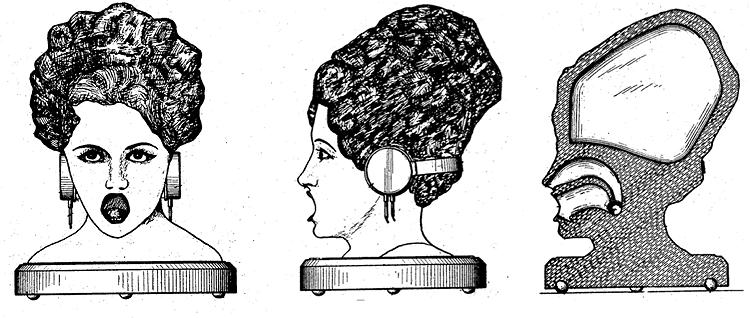
The resemblance to a sex doll has to be coincidental, because they weren't invented until after World War II. (The claim that Hitler invented the first sex doll is apparently a hoax).
Posted By: Alex - Sun Mar 14, 2021 -
Comments (2)
Category: Inventions, Patents, Music, 1920s
Breath Deflector
In case your bed partner has bad breath.Patented in 1922 by Darwin Comings of Scranton, Pennsylvania.
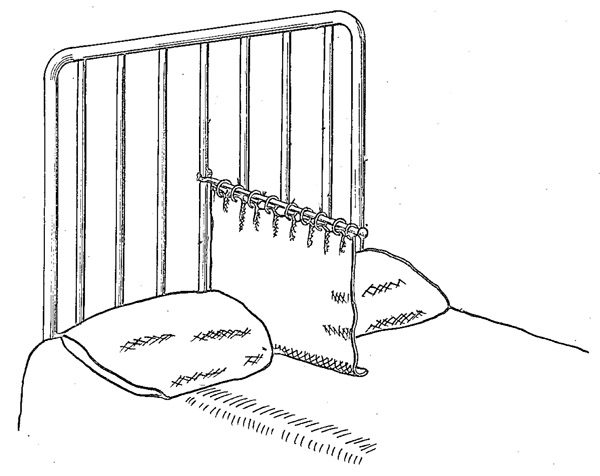
Posted By: Alex - Sun Mar 07, 2021 -
Comments (0)
Category: Furniture, Inventions, Patents, Sleep and Dreams, 1920s, Smells and Odors
Baitinger’s Automatic Eater
I posted last week about a 1940's invention which envisioned putting restaurant diners on a conveyor belt so that they could be carried past food stations. Several readers commented that the Japanese have embraced the opposite concept, of putting the food on a conveyor belt so that it travels past the diners.I did some research and discovered that the origin of the idea of having food on a conveyor belt traces all the way back to 1919 when John Moses Baitinger of Minnesota applied for a patent on this concept, which he called his "Automatic Eater". His patent was granted in 1923. He had small wooden cars, laden with food and drinks, moving along tracks, pulled by a system of cables.


Karal Ann Marling discusses some of the history of Baitinger's invention in her book Blue Ribbon: A Social and Pictorial History of the Minnesota State Fair:
The ensemble was the invention of the Reverend J.M. Baitinger, an Evangelic churchman, who stationed himself out in front with a megaphone to ballyhoo a new era in state fair dining: "Haba! Haba! Haba! This is the place to be merry. Eat! Eat! Eat! All you want for 50 cents; for without a full stomach you cannot enjoy the fair. Haba! Haba! Haba!"
The Automatic Eater cost Baitinger more than one thousand dollars to build but, because of its novelty and the economies it permitted, the cafe more than paid for itself during a trial run conducted on the last few days of the 1920 fair. "Through the medium of the Automatic Eater," he stated the following summer, "I do away with all excess help and employ only one cook, a dish washer, and a woman to keep the train well stocked with food. I pay no attention to what my customers eat, how long they stay or how much food they consume." But there were healthy profits, which Baitinger turned over to a St. Paul hospital.
Baitinger's Eater was, in many ways, a perfect expression of the mentality of the automation-mad 1920s, obsessed with speed, technology, and efficiency. There were minor drawbacks to the system, however. Diners seated near the end of the line sometimes found that the only cargo left for the eating was boiled cabbage.
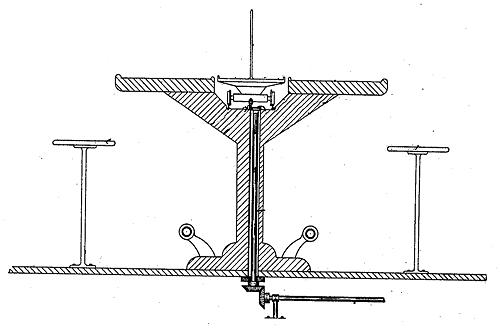
Posted By: Alex - Sun Feb 28, 2021 -
Comments (2)
Category: Food, Inventions, Patents, Restaurants, 1910s
The Snore Consumer
I've come across reports in early 20th-century newspapers of an invention, designed to stop snoring, that worked by directing the sounds of the snoring into the snorer's own ear.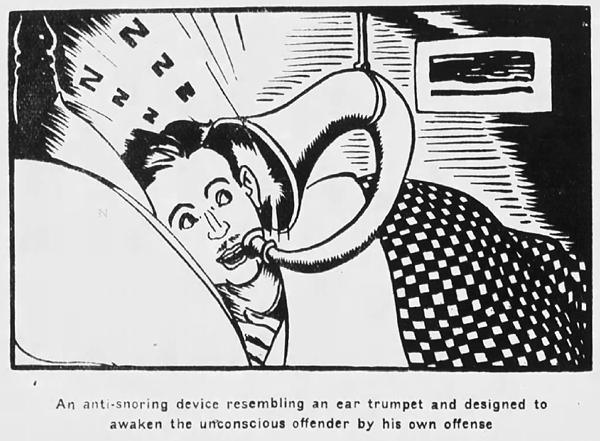
Oakland Tribune - Nov 26, 1933
I'm not sure if anyone ever really built this device, or if it was just a joke repeated by reporters.
The earliest report of it I've been able to find ran in newspapers in 1871. It attributed its invention to an unnamed woman from Iowa. However, I haven't been able to find a record of anything resembling this in the U.S. Patent Office, although there are numerous patents for anti-snoring devices.
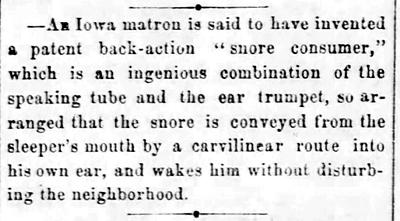
Atchison Daily Champion - Feb 24, 1871
Posted By: Alex - Thu Feb 25, 2021 -
Comments (0)
Category: Inventions, Patents, Sleep and Dreams, Nineteenth Century, Cacophony, Dissonance, White Noise and Other Sonic Assaults

| Who We Are |
|---|
| Alex Boese Alex is the creator and curator of the Museum of Hoaxes. He's also the author of various weird, non-fiction, science-themed books such as Elephants on Acid and Psychedelic Apes. Paul Di Filippo Paul has been paid to put weird ideas into fictional form for over thirty years, in his career as a noted science fiction writer. He has recently begun blogging on many curious topics with three fellow writers at The Inferior 4+1. Contact Us |




